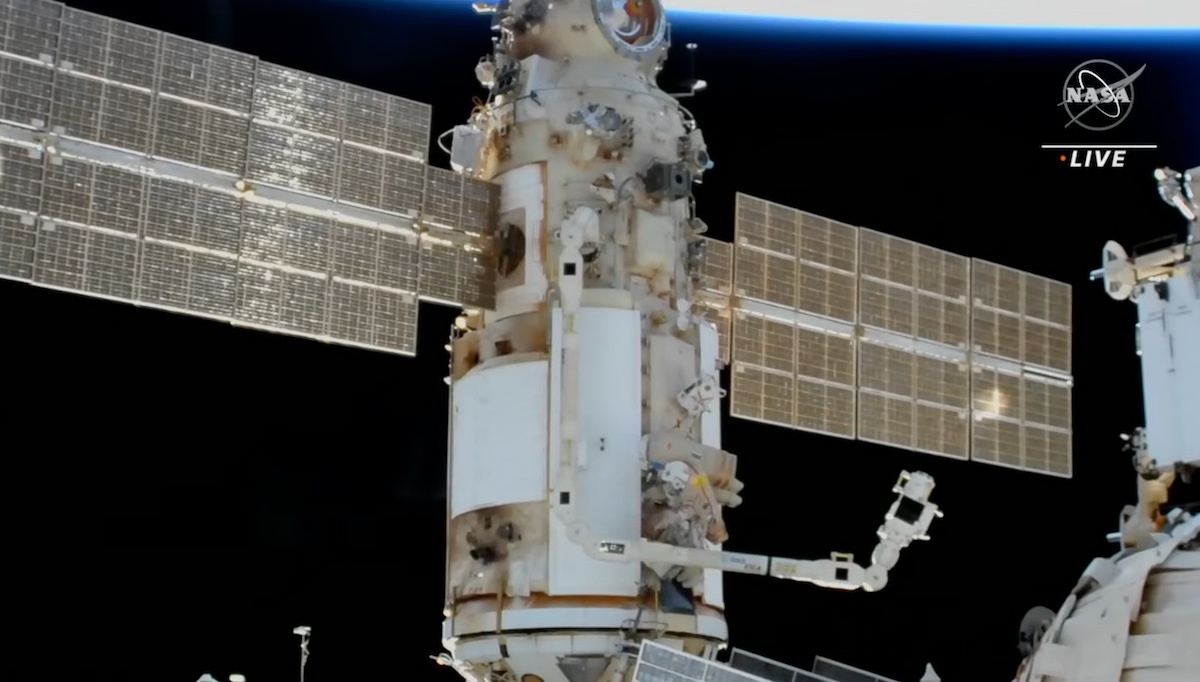18.08.2022

Russian ground controllers ordered International Space Station commander Oleg Artemyev back to the airlock after data showed voltage fluctuations in his spacesuit Wednesday, cutting short a spacewalk to continue outfitting the European Space Agency’s robotic arm delivered to the complex last year.
Artemyev and Denis Matveev, wearing Russian Orlan spacesuits, opened the hatch of the the Poisk airlock module at 9:53 a.m. EDT (1353 GMT) Wednesday to begin a planned six-and-a-half hour spacewalk.
The primary focus of the spacewalk was to continue readying the European Robotic Arm for regular operations. The 37-foot-long (11.3-meter) arm launched last July on Russia’s Nauka multipurpose laboratory module, and joins similar Canadian and Japanese arms outside the space station.
But telemetry from Artemyev’s spacesuit showed a problem in its power system a little more than two hours into the spacewalk. The data indicated the battery-powered suit was experiencing voltage fluctuations, prompting Russian mission control to order Artemyev back to the airlock to plug into the space station’s power supply.
“I have a message, voltage low,” Artemyev radioed Russian ground controllers around 12 p.m. EDT (1600 GMT).
An engineer at Russia’s mission control center near Moscow warned Artemyev he would lose communications if his suit ran out of power.
Russian flight director Vladimir Solovyov then jumped on the line to tell Artemyev to head back to the safety of the airlock.
“Oleg, this is Solovyov,” he said. “Drop everything and start going back (to the airlock) right away. Oleg, go back and connect to station power.”
“Yes, I copy and understand, immediate return to airlock,” Artemyev replied.
“Yes, and connect to station power,” Solovyov said.
“Affirmative, connect to station power.”
Rob Navias, the commentator for NASA TV’s coverage of the spacewalk, said Artemyev was not in any danger due to the power system fault.
While Artemyev returned to the airlock and connected his suit to staton power, Matveev remained at the European Robotic Arm worksite to secure the arm. Russian managers then decided to call an early end to the spacewalk.
The cosmonauts closed the hatch to the Poisk module at 1:54 p.m. EDT (1754 GMT), officially ending the spacewalk with a duration of 4 hours and 1 minute.
Before the voltage fluctuations, the cosmonauts completed the installation of two cameras on the elbow of the European Robotic Arm, and moved insulation and a launch restraint from one of the arm’s two end effectors, or hands.
The work left incomplete included the relocation of the arm’s external control panel, and testing of a rigidizing mechanism on the arm that will be used to grasp payloads for movement outside the station.
The Canadian and Japanese robotic arms are positioned outside the U.S.-led segment of the space station, while the Russian segment is accessible to the European arm. Like the Canadian robotic arm, the European arm has the ability to “inchworm” between grapple fixtures, or base points, at multiple locations on the space station.
The excursion Wednesday marked the 252nd spacewalk for assembly, maintenance, and upgrades of the International Space Station, and the seventh outside the ISS this year. It was the fourth spacewalk primarily dedicated to preparing the European Robotic Arm for operations.
Full-scale development of the European Robotic Arm began in 1996, and the arm was in storage more than a decade to wait for Russia’s Nauka lab module to be ready for launch. The European arm, primarily built in the Netherlands, was originally planned for launch on a NASA space shuttle.
“ERA is a bit different than the other manipulators that already on the station,” said Philippe Schoonejansm, the European Space Agency’s ERA project manager, last year. “It can be fully preprogrammed in advance, which is helpful. It can be operated from external control panel, which the others do not have. So even when you’re doing a spacewalk, you can control ERA by just seeing and operating this control panel. But also it can operated from inside using only a laptop, so it doesn’t need any joysticks.”

ESA says the arm capable of carrying a load of more than 17,000 pounds, or 8 metric tons, with a precision of one-fifth of an inch (5 millimeters). It will be used to transfer instruments, payloads, and other equipment outside the Russian section of the space station.
During Wednesday’s spacewalk, the two cosmonauts also planned to relocate a telescoping Strela boom from the Zarya module toward the Poisk airlock to help facilitate movement of crew members and hardware on future spacewalks.
The spacewalk Wednesday was the seventh in Artemyev’s career, and the third for Matveev.
The space station crew currently consists of seven astronauts and cosmonauts from the United States, Russia, and Italy.
The Russian spacewalk occurred as the U.S. spacesuits on the International Space Station remain unavailable for all but emergency spacewalks. NASA is investigating the cause of a water leak noticed during a March spacewalk using a U.S. spacesuit. Weather permitting, a SpaceX Cargo Dragon spacecraft is set to depart the station as soon as Thursday and splash down off the coast of Florida, returning the leaky suit to Earth for inspections.
Quelle: SN

